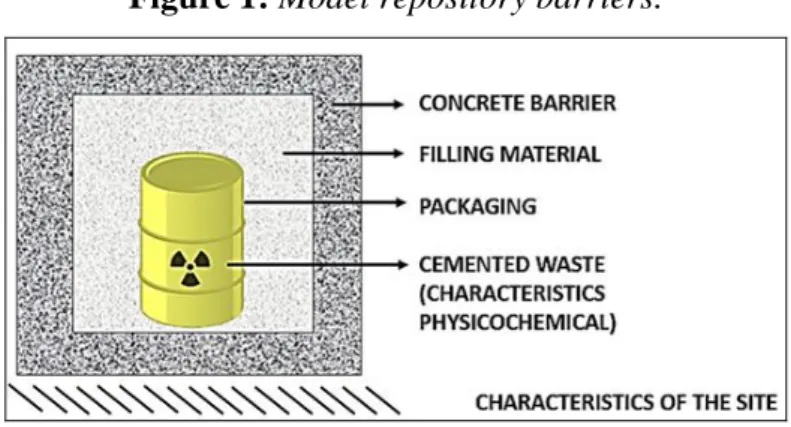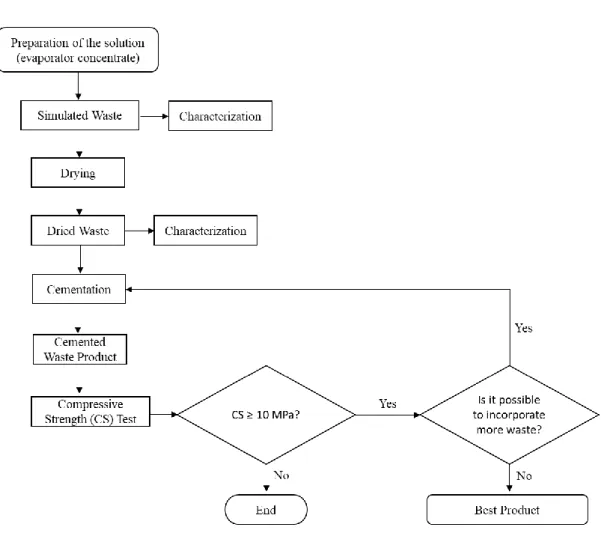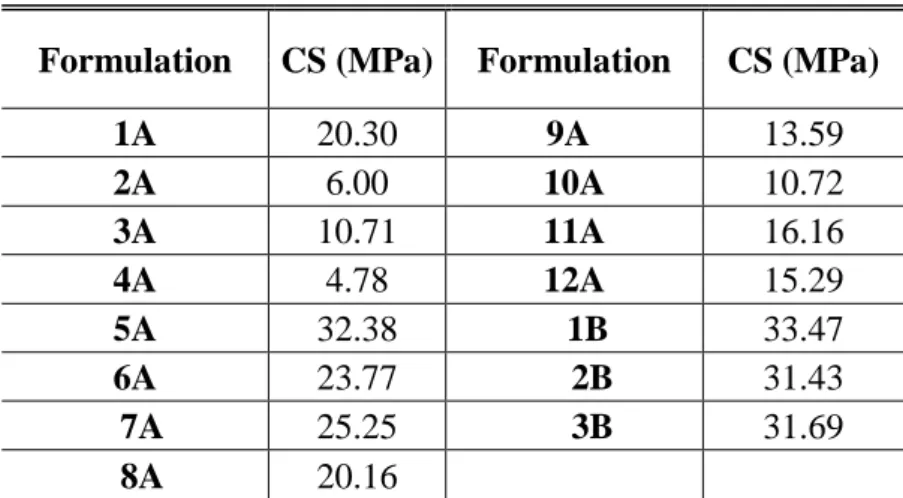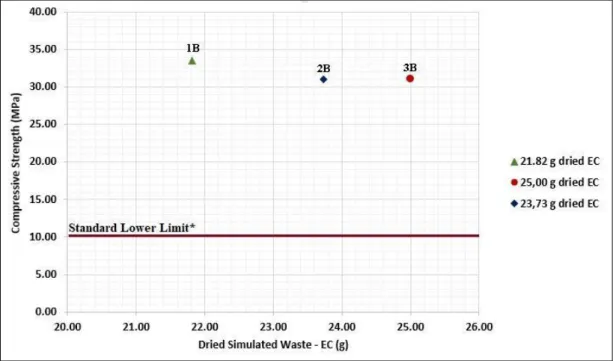BJRS
RADIATION SCIENCES
07-02A (2019) 01-11ISSN: 2319-0612
Establishment of cementation parameters of dried waste
from evaporation coming from NPP operation
Érica Rodrigues de Faria¹, Clédola Cássia Oliveira de Tello¹, Bruna Silveira Costa²
¹Centro de Desenvolvimento da Tecnologia Nuclear²Universidade Federal de Minas Gerais
e-mail: ericarodriguesfaria@gmail.com
ABSTRACT
The radioactive wastes generated in Brazil are treated and sent to initial and intermediate storages. The “Project RBMN” proposes the implantation of the Brazilian repository to receive and permanently dispose the low and intermediate level radioactive wastes. The evaporator concentrate (EC) is one of liquid wastes generated in a Nuclear Power Plant operation and usually it is cemented directly inside the packing. The aim of this work was to increase the amount of the incorporated waste in each package, using the drying process before the cementa-tion, consequently reducing the volume of the disposed waste. Drying and cementation parameters were estab-lished, aiming to obtain cemented waste products that comply with the requirements of Brazilian standard “Ac-ceptance Criteria for Disposal of Low and Intermediate Radioactive Wastes (LIRW)”. The evaporator concen-trate (EC) was dried in lab oven and the dried EC was cemented, varying the amount of cement, dry waste and water. In the preliminary studies, it was incorporated 5% of dried EC in the product, using water/cement ratio of 0.27. This result suggests the possibility of continuing the research to improve the EC incorporation.
Keywords: waste, dried process, cementation, acceptance criteria, repository.
1. INTRODUCTION
The production of energy by a Nuclear Power Plant (NPP) has advantages over other types of sources. The biggest one is an environmental advantage: it does not use fossil fuels, preventing the gas release, into the atmosphere, which is responsible for increasing global warming and formation of other toxic products. In addition, nuclear power plants occupy relatively small areas, can be in-stalled near the consumers, and do not depend on climatic factors. The fuel, uranium, is a low-cost material, since the global reserves are large and there is no risk of lack of provision on the middle-term [1].
In the world, there are 441 power reactors, 63% are PWR (Pressurized Water Reactor) type, in-cluding the Brazilian ones: Angra 1 and Angra 2 (in operation), and Angra 3 (under construction). These NPPs are in the site of Central Nuclear Almirante Álvaro Alberto – CNAAA [2]. To control the fission nuclear reactivity, avoiding uncontrolled chain reactions, boron is used as moderator [3]. Some liquid wastes generated in a NPP are treated by evaporation which involves the distilla-tion of the solvent present in the waste, leaving a small volume of residue containing radionuclides and inactive salts. Evaporation present two advantages: a high volume reduction and a good decon-tamination factor (DF) for wastes without volatile nuclides from 104 to 106 [4, 5, 6].
Currently, the wastes from CNAAA are treated and stored in initial storage facilities. The solidi-fication of the evaporator concentrate is its incorporation in a matrix, which can be cement (Angra 1) or bitumen (Angra 2) [7].
The cement is a material widely used in low and medium activity wastes, due to the accessibil-ity, low cost, simplicity in the process and it is carried out at room temperature [8]. It also present the advantage of its compatibility with water, and the high density and mechanical strength of the cemented product. Nevertheless, an issue of the cementation is the increase of the final volume. In order to cross this barrier, the evaporator concentrate should be reduced before cementation. An option for reducing the volume of waste is to dry it [9, 10, 11].
Toscano [9] investigated the feasibility of drying to reduce the volume of the evaporator con-centrate. He studied the waste characteristics, different equipments and drying processes. In addi-tion, he established the main process parameters.
The standard CNEN NN 8.01 - Management of Low and Intermediate Waste Levels - establish-es the classification of radioactive waste and its management from the segregation until final dis-posal, ensuring that the lowest waste volume comes from nuclear activities [12]. According to the standard CNEN NN 6.09 - Acceptance Criteria for Disposal of Low and Intermediate Radiation Level Radioactive Waste (LIRW) – the liquid waste must be homogeneously incorporated in a ma-trix with a minimum of segregated material, producing a monolithic product in a packaging ap-proved by Brazilian National Nuclear Energy Commission – CNEN. These standards define the necessary criteria for a secure and safely disposal of the radioactive low and intermediate radiation level wastes [13].
The Brazilian Repository, whose project is in progress, will receive and store the treated low and intermediate level radioactive wastes [14]. Its concept is a multi-barrier, repository as packag-ing, filling material, concrete barriers and near field (Figure 1) [15].
Figure 1: Model repository barriers.
Source: Adapted from [15]
In order to better comply with the requirements, experiments are being carried out with evapora-tor concentrate. The objective was to define the best route for the drying process and subsequently cementation. In this way the cemented product could has the maximum waste amount, maintaining its quality.The tests described in this work were preliminary and are described as the initial proce-dures.
1. MATERIALS AND METHODS
The methodology was developed according to the flowchart presented in Figure 2.
Figure 2: Methodology flowchart.
For the study, a solution of the waste was prepared to simulate the PWR evaporator concentrate (EC) as presented in Table 1. This simulated waste was kept in 80 °C to avoid the boron precipita-tion. In this waste, the density and the pH were determined using a pycnometer and an electronic pHmeter, respectively.
Reagents Quantity Reagents Quantity
MgCl2 0.082 g Ca(NO3)2 1.591 g
SiO2 0.089 g NaOH (1.023N) 39.50 mL
NaCl 0.374 g H3BO3 369.0 g
Al2O3 0.800 g
This solution was characterized before and after the drying process. The measured parameters were the density, the pH and the boron amount.
2.1 Drying
As presented by Toscano [9], there are many drying processes and different equipment can be used. For this research, the evaporation using a lab oven was chosen, because of its easy control and operation. Samples of 100 mL of waste were dried for about 16 h, in the temperature of 110 ºC.
2.2 Cementation
The next step was the cementation of the dry waste. An important cementation parameter, to a good waste product, is the water/cement (w/c) ratio defined in Equation 1. A w/c range from 0.24 to 0.35 was used to solidify the waste.
The cementation was performed by variation of the dried waste content and w/c ratio, in order to find the best formulation for the following experiment. In Table 2, the experimental proposal for this solidification is presented. Aiming to compare the cementation current process (liquid EC + cement) with new route (dried EC + cement), tests 1A and 7A were carried out using the current process.
Firstly, the water and dried waste were mixed. Sodium hydroxide (NaOH) was used with the purpose to increase the pH until approximately 9. After that, the cementation could be carried out. Then Portland cement CP-V was added to the waste and they were mixed during 3 minutes, obtain-ing a homogenous paste.
Some specimens were prepared by the compressive strength tests in cylindrical molds of (5 cm x 10 cm). After 28 days of curing time, the specimens were removed from the molds, the upper and lower surfaces were sanded to level them, and they were tested in a compression machine. The for-mulations employed for the cementation are present in Table 2.
The Figure 3 contains some of the steps for the cementation of the dried evaporator concentrate and the compressive strength.
Figure 3: Steps of the dried EC cementation and the compressive strength test.
Table 2: Formulations employed to cement the dry wastes.
Formulation Simulated Waste NaOH
(g) Water (g) w/c Dried (g) Solution (mL) 1A - 147,5 - - 0.35 2A 18.18 - 5.45 146 0.35 3A 21.82 - 6.55 146 0.35 4A 18.18 - - 120 0.29 5A 21.82 - 6.55 112 0.27 6A 18.18 - 5.45 100 0.24 7A - 128.3 - - 0.30 8A 15.61 - 4.68 125 0.30 9A 15.61 - 4.68 125 0.30 10A 18.70 - 5.61 125 0.30 11A 15.61 - 4.68 100 0.24 12A 18.70 - 6.61 110 0.26 1B 21.82 - 6.55 112 0.27 2B 23.73 - 7.12 112 0.27
3B 25.00 - 7.50 112 0.27
2. RESULTS AND DISCUSSION
The Figure 4 contains the dried waste resulting from drying in laboratory oven and the evapora-tor concentrate characterization, before and after drying, is showed in Table 3.
Figure 4: Dried simulated waste.
Table 3: The characteristics of simulated evaporator concentrate.
Characteristics Waste (Solution) Waste (Dried)
Density (g.cm-3) 1.0 1.35 ± 0.02
Boron quantity (AAS) 0.98% 14.8%
Theoretically, the simulated waste should have approximately 17% of boron. Nevertheless, the boron concentration measured in the waste by Atomic Absorption Spectrometry (AAS) was 0.98%, i.e., the measure was performed only in the supernatant, which confirms the low boron solubility in water. The loss of boron, 14.8%, probably happened because the first experiments were done in an open system in the oven lab, in other words, when the waste had been drying in the oven lab, the boron might have evaporated along with water.
The compressive strength is one of the parameters to ensure the product quality. In Table 4 are the results of this test are presented.
Formulation CS (MPa) Formulation CS (MPa) 1A 20.30 9A 13.59 2A 6.00 10A 10.72 3A 10.71 11A 16.16 4A 4.78 12A 15.29 5A 32.38 1B 33.47 6A 23.77 2B 31.43 7A 25.25 3B 31.69 8A 20.16
According to Figure 4, it is observed that the cemented waste products, using the majority of the formulations, presented compressive strength value above the limit established by CNEN NN 6.09 (≥10 MPa), including the ones containing liquid waste. The products from formulations 2A and 4A did not comply the minimum value of compressive strength. In the formulations 3A and 5A, with 21.81 g of dried EC, the waste incorporation was 20% by weigh higher than the ones observed for liquid waste (1A and 7A).
Figure 4: Compressive strength in relation to w/c ratio to 1A -12A formulations.
As the formulation 5A presented the products with the highest compressive strength, it was se-lected to go on with the experiments. New formulations (1B, 2B and 3B), using w/c ratio of 0.27, were prepared. The results of compressive strength for these formulations are also presented in Ta-ble 4, and the relationship between the compressive strength and the amount of incorporated waste (EC) is presented in the Figure 6. All compressive strength values were above 10 MPa, the standard limit [13].
Figure 6: Results of compressive strength for different incorporated evaporator concentrate
amounts and w/c ratio = 0.27.
*CNEN NN 6.09.
The highest incorporated amount of dried waste was attained using the Formulation 3B with compressive strength very high (31.69 MPa), and the incorporation of the evaporator concentrate in the product was 5%. Comparatively using the other formulations these values was about 3%. To improve the process, tests to determine the drying time, the viscosity, the cemented product set time, the tensile strength and the leaching resistance will be performed.
CONCLUSION
The drying process before cementation aimed to attain higher incorporations of waste in product and consequently to reduce the number the packages to be stored. From the experiments, the select-ed w/c ratio was 0.27, because the cementselect-ed waste products using this value presentselect-ed the higher compressive strength values, and it could be possible to incorporate more waste. Besides that, it was observed that incorporation of dried waste in relation to the current process was advantageous. The maximum incorporated waste (dried EC) was 5% by total weight in the product. Despite of the good results observed at drying in a laboratory oven, we intend to use a spray dryer in order to get a better process and to study the variables and parameters that will affect the whole process – dry-ing/cementation.
3. ACKNOWLEDGMENT
We thank to Nuclear Technology Development Center – CDTN for opportunity; to Metting fi-nancial support by Foundation of the State of Minas Gerais – FAPEMIG. We thank to LABCIM (Laboratório de Cimentação), Francisco Donizete and Maria Judite for technical support.
REFERENCES
[1] ANEEL, Agência Nacional de Energia Elétrica, Atlas de Energia Elétrica do Brasil, Brasília, ANEEL, 2002. p.99-102.
[2] ELETRONUCLEAR, Panorama da Energia Nuclear no Mundo, Rio de Janeiro, 2016. 207p. [3] QINA SUN, JIANLONG WANG, Cementation of radioactive borate liquid waste produced in
pressurized water reactors, Nuclear Engineering and Design, v 240, p 3660 – 3664, 2010. [4] QINA SUN, JUN HU, JIANLONG WANG, Optimization of composite admixtures used in
cementation formula for radioactive evaporator concentrates, Progress in Nuclear Energy, v. 70, p 1-5, 2014.
[5] INTERNATIONAL ATOMIC ENERGY AGENCY. Selection of Technical Solutions for the
Management of Radioactive Waste. IAEA-TECDOC-1817. Vienna: IAEA, 2017, 114p.
[6] ABDEL RAHMAN, R. O. IBRAHIUM H. A. & HUNG, Y., Liquid Radioactive Wastes Treatment: A Review, Water, V.3, p. 554, 2011.
[7] ELETRONUCLEAR, Relatório de Impacto Ambiental da unidade 3, Rio de Janeiro, Brazil,
2006. Available at:
<http://www.eletronuclear.gov.br/Portals/0/RIMAdeAngra3/03_caracterizacao.html> Last ac-cessed: 13 Jul 2017.
[8] IAEA - INTERNATIONAL ATOMIC ENERGY AGENCY, Characterization of
Radioac-tive Waste Forms and Packages, TRS 383, IAEA, Vienna, 1997. p.138.
[9] TOSCANO, R. A. Proposição de Processo de Tratamento de Resina e Concentrado de
Evaporador Provenientes de Usinas Nucleares para o Armazenamento em Repositório de Superfície, Dissertação de Mestrado, Belo Horizonte, CDTN, 2017.
[10] TELLO, C.C.O. Avaliação de Bentonitas Nacionais como Aditivo na Cimentação de
Rejei-tos Radioativos, Dissertação de Mestrado, Belo Horizonte, UFMG, 1988.
[11] PERRY, R.H. & GREEN, D.W. Perry’s Chemical Engineers’ Handbook, 8th ed, The McGraw-Hill, New York, 2008. Cap.12 p.26.
[12] CNEN, CNEN NN 8.01 - Gerência de Rejeitos Radioativos de Baixo e Médio Níveis de
Radiação, Resolução 167/14, CNEN, Rio de Janeiro, 2014. 45p.
[13] CNEN, CNEN NN 6.09 - Critérios de Aceitação para Deposição de Rejeitos Radioativos
de Baixo e Médio Níveis de Radiação. Resolução 012/02, CNEN, Rio de Janeiro, 2002. 11p.
[14] BORSSATTO, M.F.B. Desenvolvimento de Metodologia de Gerenciamento de Riscos no
Projeto de Implantação do Repositório Nacional para Rejeitos Radioativos de Baixo e Médio Nível de Radiação, Dissertação de mestrado, Belo Horizonte, CDTN, 2013.
[15] TELLO, C.C.O. Efetividade das Bentonitas na Retenção de Césio em Produtos de





